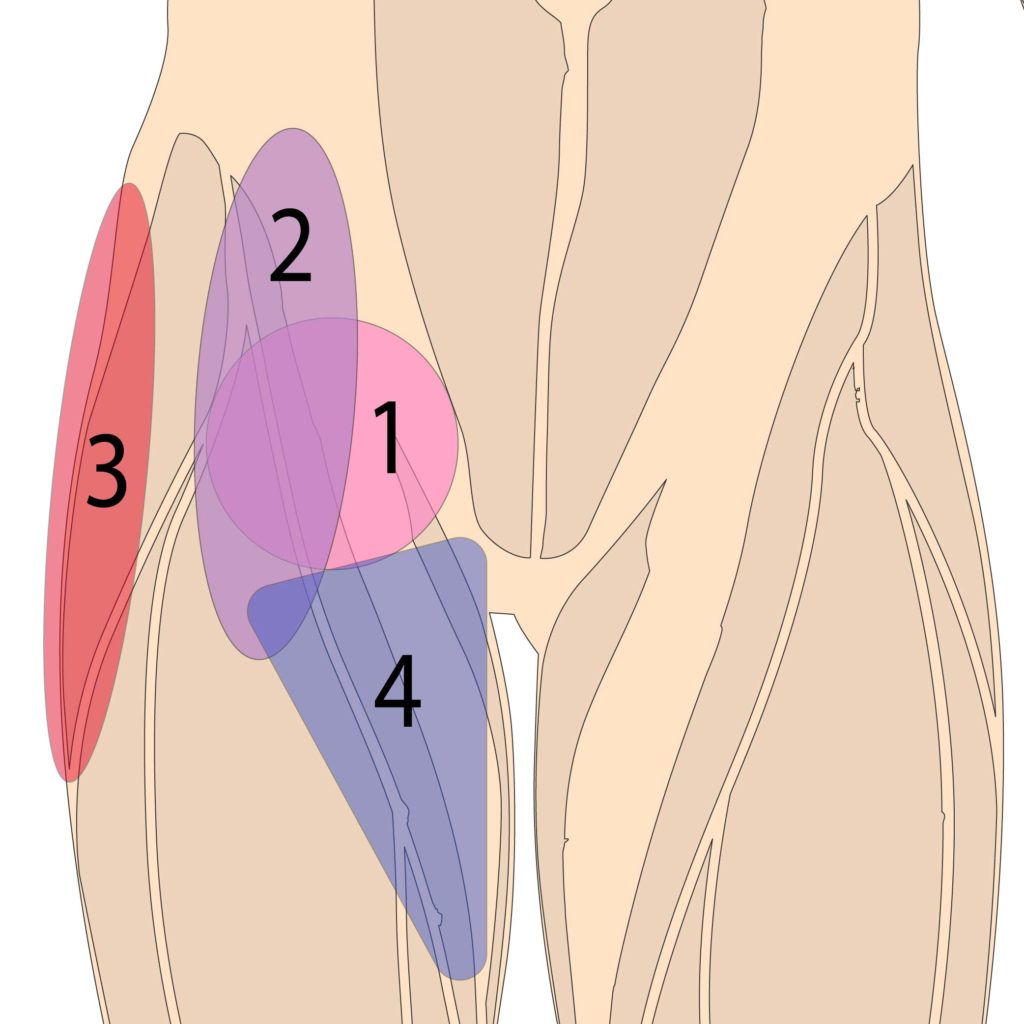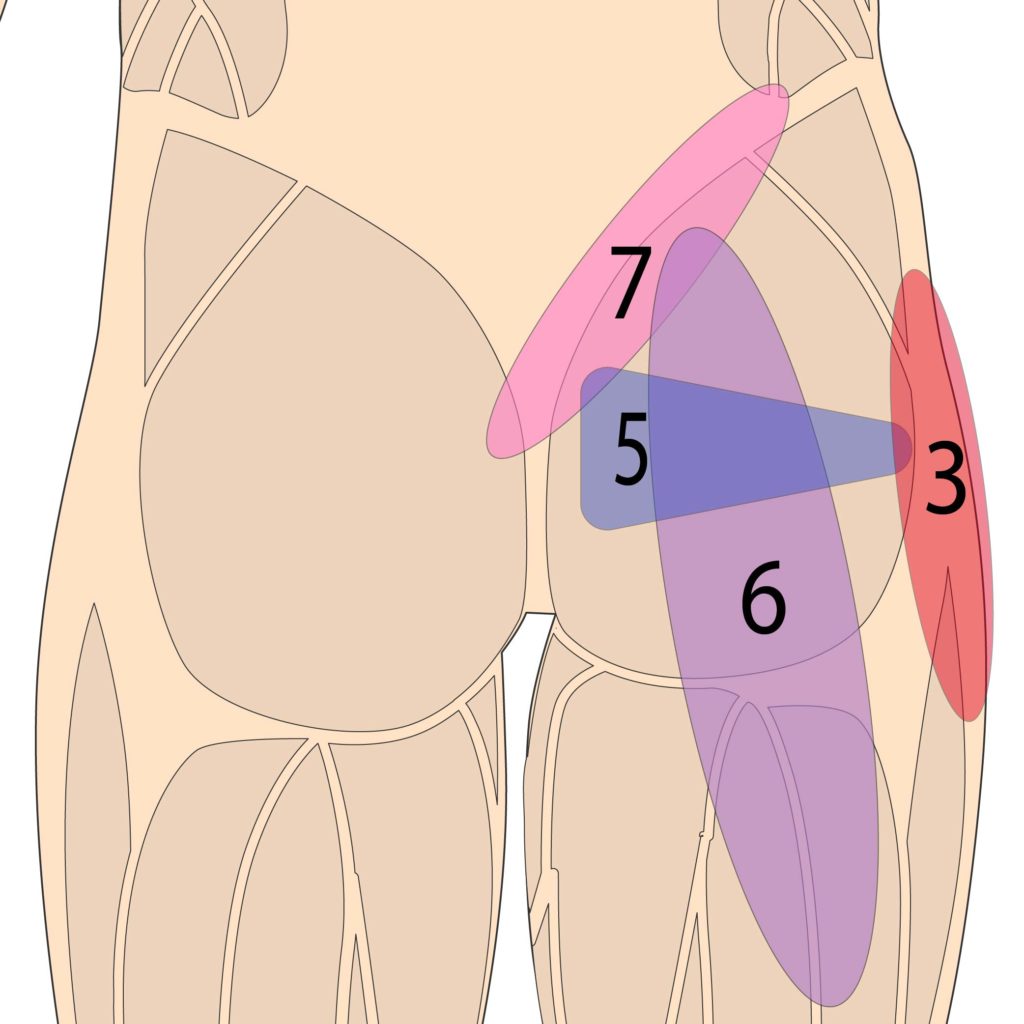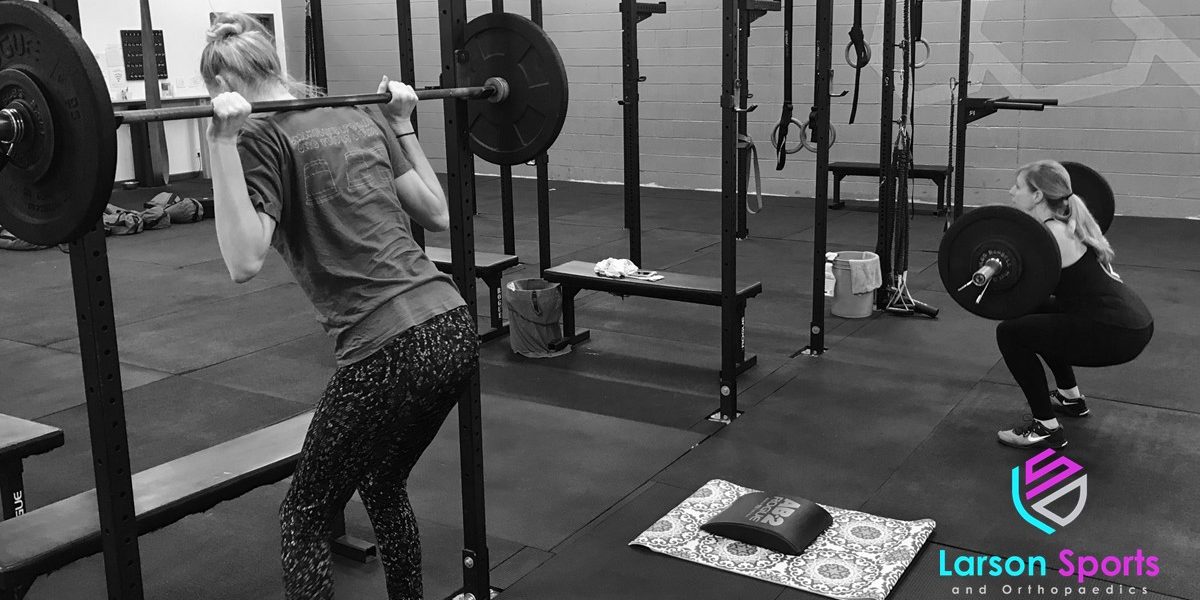What Causes Hip Pain?
Pain around the hip is very common in athletes. As an orthopedic surgeon that cares for a lot of weight lifters and functional fitness athletes, I see many different causes of hip pain. Some people get hip pain while rowing, and we’ve done a separate post about that topic. (check it out at this link.) However, many more people get hip pain when squatting.
The problem is that when people complain of hip pain, they can be referring to a wide range of medical conditions. Some of these can involve the hip joint, but most do not. True hip pain from the joint itself is usually felt deep in the groin. However, people often confuse everything from bursitis to lower back pain with true hip pathology. This post includes all of the most common sources of “hip” pain that I see in athletes, roughly in order of frequency.

Snapping Hip Syndrome
You may find that your hip pain when squatting also comes with loud popping or snapping. Several different structures around the hip can cause popping. But, in athletes, the most common one I see is Internal Snapping Hip Syndrome. This is caused by the iliopsoas (pronounced illy-oh-SO-as) tendon. The iliacus muscle and psoas muscle originate inside the pelvis and the lumbar spine. They come together to form a common tendon that goes in front of the hip and attaches to the inner side of the thigh.
In Internal Snapping Hip Syndrome, this tendon will feel stuck as it hangs on the front of the pelvis over hip then snap loudly as it pops over the bone. Pain from this is usually felt deep in the front of the hip, but can also shoot straight into the lower back. I see this problem most frequently patients that spend a lot of time on the rowing machine. However, it can also cause problems when squatting and running. Snapping Hip Syndrome is probably the most common of hip pain in my clinic. Many people worry that the snapping is coming from a torn labrum, but I have never seen a labrum tear cause snapping or popping this loud. If you can hear it snap in a quiet room, it’s almost certainly coming from the iliopsoas tendon.
Piriformis Syndrome
Running is one of the most common sports associated with piriformis syndrome, but I have seen a lot of it in weight lifters and functional fitness athletes too. The piriformis is a small muscle on the back of the hip that can cause an outsized amount of pain. It is buried in the buttock, deep to the gluteus maximus. Its function is to help stabilize and externally rotate the hip.
The piriformis lies directly over the sciatic nerve, and the muscle becomes tight or spastic it can compress the nerve and cause burning pain in the buttock or even down the hamstrings and into the lower leg. It can mimic the symptoms of a herniated disc, but specific tests like a Piriformis Stretch Test and the Straight Leg Raise can help to figure out which is the real cause. Regular piriformis stretching after working out is a simple and effective way to prevent this problem.
Trochanteric Bursitis
Pain on the side of the hip is usually related to the IT band or the bursa underneath it. There is a solid point of bone on the side of the hip, known as the greater trochanter. Many people mistake this for the actual hip joint. However, the trochanter is actually outside the joint, and it’s where many of the hip and Gluteus muscles attach. The trochanteric bursa is a thin space with minimal connective tissue between the IT band and the trochanter. But, if it becomes irritated, then thick connective tissue can fill the area, leading to dysfunction and pain. If the hip hurts directly over the bone laterally and you find it painful to sleep on your side, then trochanteric bursitis is probably the cause.
This area is most commonly a problem for runners, but it can also be painful with overuse from functional fitness workouts. If the trochanter hurts when you are squatting, it can be a sign that you are using the Tensor Fascia Lata muscle to stabilize your hip rather than the Gluteus Medius. This is something to work on with your coach or physical therapist. But a good place to start can be keeping the toes pointing a bit closer to forward.
For more on the topic of Trochanteric Bursitis, as well as how to prevent and treat it, be sure to read my article “The REAL Cause of Trochanteric Bursitis.”
Hip Impingement and Labrum Tear
When people come to see me for hip pain, this is almost always the problem they are concerned about. Despite what the rest of the internet tells you though, it is not that common of a problem. To be sure, many people will have an MRI reading that says they have a labrum tear. Unfortunately, radiologists frequently think there is a tear of the hip labrum. This reading can be found on up to 80% of people who don’t have hip pain. So my job usually involves figuring out whether that tear is real and if it is the source of pain. In most cases, it isn’t.
An abnormal shape to the ball or socket usually causes hip impingement. You can think of it as trying to fit a square peg in a round hole. When the ball and socket shapes don’t match, it leads to excess pressure when trying to reach full depth on squats. These hip abnormalities develop during our later growth, typically during teenage years. Impingement can also be”functional” instead of anatomic if your pelvis tips forward during a deep squat. This type of impingement can be corrected with proper form and coaching and is an easy way to prevent hip pain when squatting.
Chronic impingement can lead to damage to the cartilage and labrum in the hip over time. This is the most common cause of hip labrum tears. People most frequently feel this problem in the front or side of the hip. They feel like they can’t quite point directly to the painful area. People often make a “C Sign” when trying to point to the pain, encompassing most of the front part of the hip.
Groin Strain or Tear
While it is possible to tear just about any muscle with sporting activity, the hip adductors seem to be the most prone to injury while lifting weights. These are the muscles we typically refer to as “groin” muscles, along the inner side of the thigh. Several of my patients have injured these muscles during squats or box jumps. I’ve also seen people tear the quadriceps and hamstring tendons where they connect to the pelvis. These often occur during a forced eccentric contraction, like the final move of a clean and jerk. But they can also occur when straining under a heavy squat. These tears can usually be treated without surgery, but they can take months to recover from fully.
When you tear a muscle, you’ll know it immediately. This is a sudden searing pain that drops you to the ground. You’ll have the sickening feeling that comes when something is very wrong. Conversely, if you hurt the day after lifting, that’s just normal DOMS, not a muscle tear. Not familiar with the term DOMS? Well, you can learn more about this common cause of pain from lifting in our article on the subject at this link.

Hip Arthritis
With more people lifting weights and staying active well past 40 years old, we see many more active people with arthritis. While sports injuries can put you at risk for hip osteoarthritis, obesity can as well. Moreover, one of the major causes of hip arthritis is mild dysplasia or impingement, two situations where the hip joint isn’t exactly spherical. So hip arthritis often has nothing to do with how active you have been.
Hip arthritis usually causes pain in the groin. It can be a dull aching that gets worse slowly over time. People will often notice pain in the groin when they start working out, but find that it goes away after they warm up. However, it comes back worse again that night after they have been sitting down for a while. Sometimes the pain of arthritis can come on suddenly. Your X-Rays may show that you’ve had arthritis for years, but you only started feeling it after a slip or fall. For more on the subject, check out our articles “What Is Arthritis?” and “Exercising After A Joint Replacement.”
Sciatica
Many people think the pain in their buttock is coming from the hip. However, pain in the buttock region rarely comes from the hip joint itself. If you have pain in the buttock, it is often due to sciatic nerve compression, especially if it is accompanied by burning into the back of the thigh and calf. Numbness and tingling often go along with this and track into the lower leg or foot. But no problem inside your hip joint itself can produce numbness and tingling.
Numbness and tingling almost always indicate that the pain is due to pressure on a nerve. If that is in the buttock, it usually means your sciatic nerve. This can be caused by arthritis or herniated discs in the lower back. Unfortunately, common problems are common. So weightlifters and functional fitness athletes will have a pretty high lifetime risk of sciatica, simply because about 70% of all people will have this problem at some point. Surprisingly, people usually don’t have back pain with a herniated disc. Most people with sciatica due to a herniated disc will only have pain from the buttock down through the leg and into the foot, without any back pain at all.
Sacroiliac Pain
The sacrum is the lowest portion of your spine, and the sacroiliac joint (SI Joint) is the junction between your spine and pelvis. This joint has minimal if any motion during daily activities but can still be painful. The SI joint is part of your back, but many patients will think the hip is the source of the problem. If your pain is near the bony spot between the buttock and the lumbar spine, it’s probably sacroiliac pain. The FABER test is one of the most common tests for sacroiliac pain. You may first notice sacroiliac hip pain when squatting, but it will usually progress to hurting all the time, even when sitting or walking.
In my clinic, this is a problem that primarily affects athletic women after childbirth, where the SI joints can be traumatized by the changes that happen during delivery. However, it can also occur from repeated stress and overuse as well. In these cases, we often see significant asymmetries in strength or mobility. Tight hip flexors, scoliosis, or weak core and pelvic floor muscles can lead to imbalanced forces on the SI joint. Eventually, that will produce enough stress to cause pain.
Stress Fracture
Stress fractures typically affect endurance athletes such as long-distance runners. So if your primary sport is weight lifting and functional fitness WODs, you are at very low risk for a stress fracture of the hip. However, if weightlifting is just a small part of your weekly routine to help cross-train for long distance running, you could still be at risk. While stress fractures can lead to hip pain when squatting, they are usually due to excessive running.
A stress fracture of the hip occurs just below the ball of the joint, at the top of the femur. A stress fracture of the hip will usually cause pain deep in the groin, which is where we typically feel pain from any problem in the actual hip joint. It will often seem like a nagging pain. Many people are diagnosed as having a chronic groin muscle strain. The best way to check for this diagnosis is to get an MRI of the hip itself. Because it may not show up on an X-Ray until it has actually snapped clean through!
Works Cited
TM Clough. “Femoral Neck Stress Fracture: the Importance of Clinical Suspicion and Early Review.”
Schmitz, Matthew R, et al. “Identification of Acetabular Labral Pathological Changes in Asymptomatic Volunteers Using Optimized, Noncontrast 1.5-T Magnetic Resonance Imaging.”

